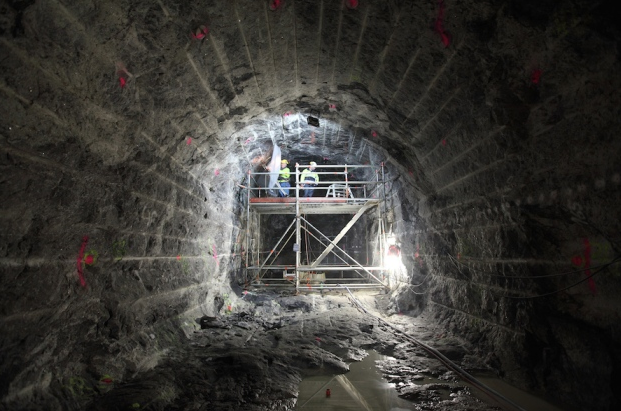
By Anne Lindsey
What does “consent” mean? It’s a loaded question under any circumstance, sometimes with a legal definition, but consider the case of siting a repository for all of Canada’s high level radioactive waste (HLW). 50,000 tonnes of it and growing. The Nuclear Waste Management Organization (NWMO), consisting mainly of Ontario Power Generation, Hydro Quebec and New Brunswick Power – owners of most of Canada’s HLW – is charged by the government with finding a site and building a repository. The sites under consideration are down to two: Teeswater in SW Ontario, and the Revell Lake area near Ignace in NW Ontario.
Teeswater and Ignace councils expressed interest in being considered for a repository site. NWMO is now going through the steps described on its website towards a final decision. Step 5 is “Acceptance to host the repository is confirmed.” At one point, this step read “Acceptance will need to be supported by a compelling demonstration of willingness”. But however worded, this is all about consent, and nowhere has “consent” been defined, nor has the process to be used in its determination.
This is highly problematic, particularly in NW Ontario, where the site is not actually in Ignace. Revell Lake is in Treaty 3 territory, or Crown Land, 45 km from the Town of Ignace. The site of borehole drilling investigation sits on the watersheds of both the Rainy River (flows into Lake of the Woods which drains into the Winnipeg River and then Lake Winnipeg), and the English River (flows north via Lac Seul into the Winnipeg River and then Lake Winnipeg).
Why is this important? Manitobans may recall the Underground Research Lab in the 1980s near Lac du Bonnet. There, the nuclear industry was studying how to dispose of HLW within “solid” Canadian Shield rock by drilling a deep shaft and investigating its properties. It did not surprise local hard-rock miner and farmer, the late George Ylonen, that pumps were run constantly way down in the shaft to prevent flooding from the ever present and flowing groundwater. Groundwater connects to surface water.
Deep underground it’s not necessarily dry and that’s a problem because even though HLW will be encased in (today’s) state of the art containers, grouted and sealed, it remains radioactive and toxic for millennia and no containment has ever been shown to last that long. Radioactive waste and its by-products do not belong in water. Despite industry predictions of safety, Manitobans were not convinced. Our High Level Radioactive Waste Act, banning nuclear waste disposal in this province, became law in 1987.
Eventually, the underground lab was closed, but under Federal law, the NWMO was formed, the basic concept of deep geologic burial was affirmed, and the hunt began for a “willing” site. HLW production continued unabated, mainly in Ontario and New Brunswick. HLW’s existence poses an ongoing dilemma for a pro-nuclear federal government wanting to get it out of sight, and out of mind.
The situation becomes more urgent as Natural Resources Canada is now touting development and deployment in northern remote communities of so-called “new generation” modular nuclear reactors. Besides trying to justify the outrageous expense and safety concerns of these proposed products, they also must answer the burning questions about managing their inevitable high level waste.
No country in the world has yet successfully developed a geologic repository for HLW.
Scenarios of radioactive contamination hundreds of years into the future are not the only reason to be concerned about a NW Ontario site. Environment North researcher, Dodie LeGassick, reports that one of the most common highway accidents in northern Ontario is big rig/transport truck collisions. (The kind of truck that would transport loads of waste several times a day for at least 40 years from southern Ontario and points east). The worst stretch for these collisions is the 182 km between Shabaqua (50km west of Thunder Bay) and Ignace where 98 of 149 collisions in 2019 involved big rigs. A brief dip in the statistics due to Covid 19, doesn’t hide the fact that over the years, those accidents have steadily increased in frequency.
Industry is determined to show that the transport containers are virtually unbreachable. According to LeGassick, NWMO is in Ignace area schools showing children that even when dropped from a great height, a good container can keep its contents safe. (They apparently use an egg for demonstration purposes). But what if the container holds radioactive and water-soluble Cesium 137 – an element that mimics potassium and is therefore easily taken up by living organisms? It is an important component of HLW. Anyone using water in NW Ontario and the Winnipeg River watershed for drinking, fishing, harvesting, washing, recreating, could be forgiven for thinking the risk of a transportation spill is too great, let alone a massive permanent underground repository.
But who gets to make the decision? Whose consent is required? Treaty 3 First Nations? They have already passed a resolution rejecting nuclear waste in their traditional territory. The towns of Dryden and Kenora? Communities along the transportation routes? Thunder Bay has already spoken out against it. Fishing, hunting and wilderness guide companies that dot the landscape? Seasonal cottage owners?
In a related but separate exercise and after 75 years of promoting the nuclear business, the federal government is finally beginning to develop a policy for radioactive waste. Figuring out things like deciding where the waste goes and how that is decided must be high on the agenda.


